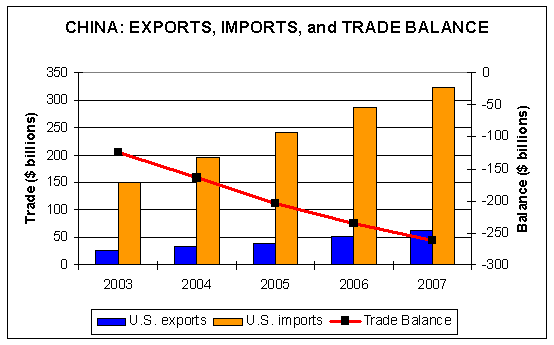View Section in Publication :: Return to Overview

Key Economic Events
- The U.S. merchandise trade deficit with China accounted for 29 percent of the total U.S. trade deficit in 2007, up from 26 percent in 2006. In 2007, China overtook Japan to become the third largest market for U.S. exports and overtook Canada to become the leading supplier of U.S. imports.
- U.S. exports of transportation equipment, chemicals and related products, and agricultural products accounted for nearly two-thirds of the increase in U.S. merchandise exports to China in 2007. Increased U.S. transportation equipment exports reflected growing demand for air travel and continued infrastructure spending, while continued urbanization, population growth, and income growth contributed to increased agricultural exports.
- U.S. imports of electronic products, miscellaneous manufactures, and textiles and apparel collectively accounted for 70 percent of the increase in U.S. merchandise imports from China in 2007. Increased U.S. imports from China in each sector represent increased production capacity in China to take advantage of various factors, such as labor productivity and labor abundance, which make China a low cost production center.
Trade Shifts in 2007 from 2006
- U.S. trade deficit: Increased by $26.6 billion (11 percent) to $262.1 billion
- U.S. exports: Increased by $9.4 billion (18 percent) to $61.0 billion
- U.S. imports: Increased by $36 billion (13 percent) to $323.1 billion
USITC Publications
Other Government Resources
- U.S. Central Intelligence Agency: World Factbook
- U.S. Department of Energy, Energy Information Administration: Country Analysis Brief - China
- U.S. Department of State: Background Note - China; China Business Information Center
- U.S. Department of Commerce: Office of China Economic Area (OCEA)
- People's Republic of China, Ministry of Foreign Affairs: Office of North America and Oceania;
- People's Republic of China, Ministry of Commerce
- U.S.-China Economic and Security Review Commission: 2007 Annual Report
- Congressional Budget Office: How Changes in the Value of the Chinese Currency Affect U.S. Imports


















